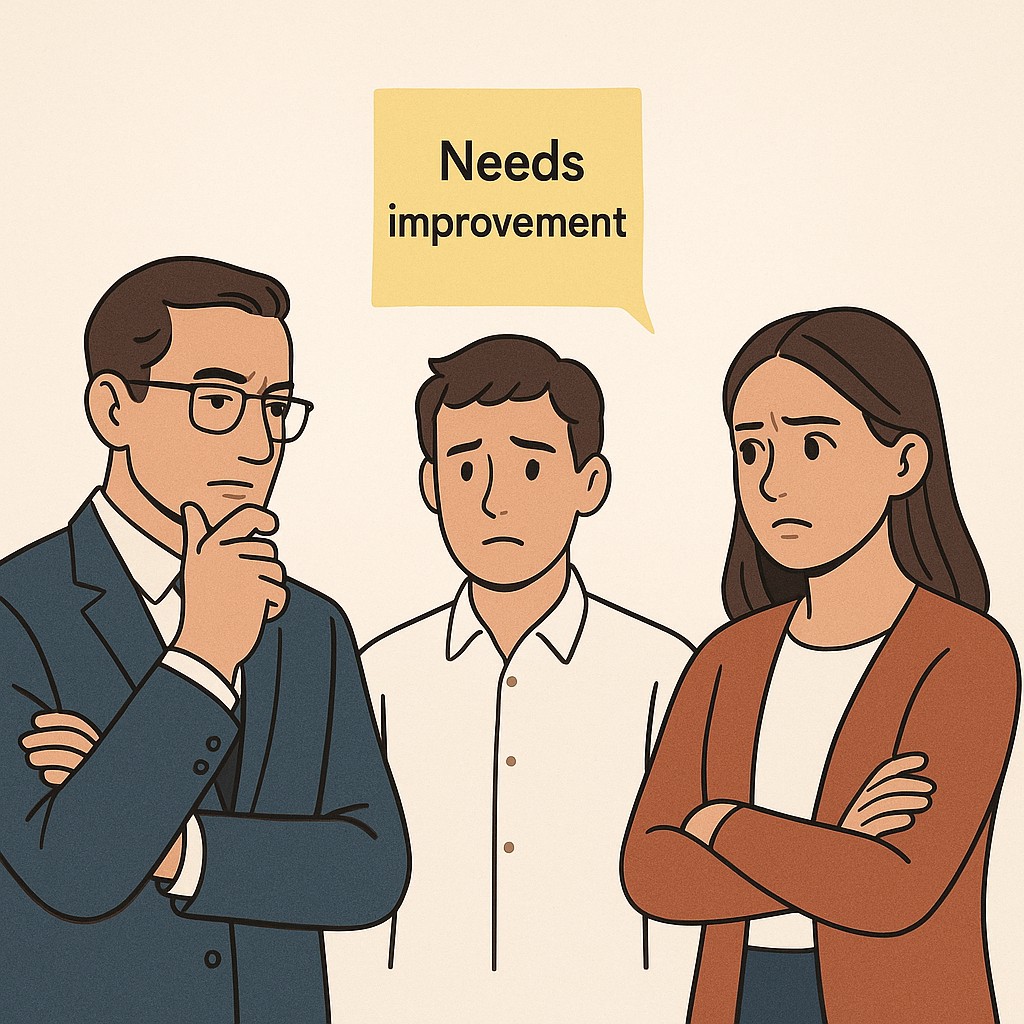Tailor Feedback Across Levels: Make Your Message Land
Tailor Feedback Across Levels: Make Your Message Land

Feedback That Lands: Why Power Changes The Message
Let me take you back to Day 5 of our Feedback Series—right in the middle of a sprint. We kept running headfirst into the same snag. Our build pipeline choked on one slow step, stretching every release. The grumbling was loud, and yes, I was right there too. Everyone passed the issue up to our manager. Or tried to—nothing changed. It felt like we were shouting across a canyon. Only when someone laid out the actual numbers—showing our releases were taking three times longer than they should—and suggested a specific route to automate that bottleneck, did we finally get buy-in. Suddenly, the problem wasn’t just noise. It was visible and solvable.
Here’s what that moment drilled into me. When we fail to tailor feedback across levels, it usually bounces off. Managers tune out, teammates get defensive, and direct reports might not even know where to start. That sprint mess made it painfully clear—the usual feedback routines just weren’t working.
Plain and simple: power dynamics matter.
Swapping vague complaints for hard data made all the difference. Instead of “the build is always slow,” saying “this step takes 3x longer than any other—here’s a quick proposal that could help” put a real fix on the table. The conversation shifted from frustration to action.
So I used storytelling to frame feedback as a possible blind spot and made it a direct ask. “I noticed our builds dragging because of that step. Should we automate it?” That approach didn’t just surface the issue. It opened up space for a decision, not another round of defensive back-and-forth. If you’re facing stalled feedback, start here. The way you deliver the message matters more than the words themselves.
Calibrating Feedback: Tailor Feedback Across Levels
Here’s something I’ve run into more times than I care to admit. I gave the same comment to three people—my manager, a teammate, and a direct report—and got three completely different reactions, none of them the one I wanted. It’s not just that people have their own quirks. Authority filters every bit of feedback.
When you say, “We should automate this step,” your manager doesn’t hear a request. They see a possible blind spot and start weighing impact and risk. A direct report, though, might immediately start wondering about expectations and examples—is this feedback about my work, or is it a new standard for the team? Meanwhile, a peer might feel blindsided. Suddenly it’s a directive where they expected open discussion or shared ownership. The same sentence can trigger defensiveness, confusion, or even disengagement, depending on who’s on the other end and what role power plays.

It took me a lot of trial and error to land on a way to practice directional feedback and prevent feedback from backfiring. The simplest model I use goes like this. Match your framing, your evidence, and your ask to the person’s direction in the power structure. If you issue a “must-do” directive to a peer, you’ll usually hit resistance. Toss a vague “things are slow” complaint at your manager, and you’ll probably get nothing but sympathy—with no change in sight. It’s only when each piece is properly tuned for the audience that adoption catches.
A quick gut check before you hit send or walk into a feedback conversation. Am I framing this in the best way for my audience?
Six months ago, I thought doing this was being overly cautious, maybe even a bit political. I’ve changed my mind. The time upfront actually saves you circles of debate and follow-up, precisely because calibrated feedback cuts down unnecessary back-and-forth. Let’s be honest. Not every manager will listen, even if you deliver feedback perfectly. But doing the upfront work sets you up for the best shot at progress. It’s principled, not manipulative, and it spares everyone a ton of churn.
With that model, we’re set up to tailor feedback across levels with strategies up, down, and sideways—up to managers, down to reports, sideways to peers—with practical language that actually lands.
The Upward Playbook: Flag, Quantify, Propose, Partner
Most of us learn the hard way that, with feedback to your manager, your boss might not see what’s broken—especially if it isn’t on their dashboard or flagged by their priorities. So, when you need to influence upward, start with a repeatable pattern. Name the possible blind spot, tie it to a slowed-down goal, offer a specific fix (think automation, refactor, or whatever clears the jam), and make a crisp ask for resources or support. This isn’t about extra drama. It’s about clearing fog and building momentum. If you walk in wielding data and a focused proposal, you’re not just adding noise. You’re handing them a lever to move things faster, so you can be heard without being loud.
Take the sprint example we ran through earlier to illustrate managing up feedback. Our builds were stuck on a step that took three times longer than the rest. Once we actually showed that number—3x longer—and proposed automating just that step, everything shifted. All it took was a request for dedicated time or even a small tooling budget to actually implement and measure the fix. High-quality, targeted feedback directly lowers wasted effort for teams, which also boosts motivation in the long run (Drouvelis & Paiardini, 2022). That moment taught me how clear, actionable feedback can turn a blocker into a win that ripples across the team.
Here’s the ask that landed. “I noticed our builds dragging on that slow step. Should we automate it, or at least explore what dedicated time could do here?” When you frame feedback around impact and open the door for partnership, you’re not just flagging the problem, you’re inviting your manager to co-own the solution. It’s a question, not a complaint. When you request support—whether it’s time, a budget, or just explicit buy-in—you give both of you a stake in getting to faster goals.
And here’s where my brain sidetracks, since lately I keep drifting back to food analogies—like how a good chef “seasons to taste” depending on who’s eating. I was at this little Turkish place last weekend, and the chef asked if I wanted extra Aleppo pepper or to keep it mild. Feedback’s just like spice: too much heat, and people will push the plate away. Too bland, and no one notices. If feedback’s bland or too pungent, it won’t be touched. You season feedback for the person who decides, because your goal isn’t just to serve—it’s to get them to say yes. That’s why calibrating matters. Power dynamics aren’t a side note. They’re the heart of how feedback gets adopted.
If you start with this pattern—blind spot, proof, proposal, ask—you’re not just speaking up. You’re inviting your manager to help accelerate what matters most. And the more you flex this muscle, the less you’ll feel stuck in cycles of complaint or inaction.
Coaching Reports: Clarity, Show-and-Tell, and Ownership
Let’s keep it simple. Clarity beats critique every time. A report needs to know exactly what the target is, why it matters, and what concrete steps are expected—not some vague, looming standard or a slap on the wrist. If I fall into just ordering people around, suddenly I’m that supervisor-dictator—nobody learns, and defensiveness surges (Frontiers in Psychology, 2023). The most helpful feedback is almost boring in its directness.
What’s worked best for me is show-and-tell language that makes standards feel achievable, not hidden. Say you’re nudging someone to optimize a function for scale. I set the bar. “For product growth, we need to rework X to handle real traffic bursts.” Then I offer a sketch—“Here’s how I’d start. Batch the operations, keep each below 100ms, and log payload sizes for insight.” Sharing a snippet or annotated example helps anchor not just what’s needed but why, and offers a glimpse into the mind behind the standard. I’ll always explain the tradeoffs, not just the ‘what’—maybe batching adds complexity, but it keeps us resilient when traffic spikes. And I hand it back. “How do you see tackling this? Any approaches I’m missing?”
When standards are visible and feedback is transparent, people actually feel fairness, which connects directly to how open they are to feedback (Katz et al., 2023). This isn’t just about assigning a task—it’s about building skill and shared ownership. Most reports want to deliver, but they need the runway and a clear end zone painted out.
Here’s a concrete coaching moment focused on feedback for direct reports. Let’s say you’re proposing a refactor for better scale. I’ll outline the first steps with practical detail. “Kick off by splitting out the core logic and testing response time with 1000 sample requests. Our performance target is sub-250ms per call. Pair up for a review after the first pass to trade notes and spot bottlenecks.” I always invite them to challenge my outline—tell me what’s unclear, what blockers could pop up, or how they’d tweak the approach. The best results come when reports feel free to reshape the plan, not just follow it.
Tone matters—more than I used to realize. Staying clear, direct, and genuinely curious about their thinking makes it safer for people to dig in. If you invite thoughts and reinforce the standard, you’ll see alignment and speed improve, without falling into micromanagement. Truthfully, it’s a two-way street; if the report’s pushing back or suggesting a better way, that’s a win. You’re not losing control—you’re teaching how to hit the mark together.
But there’s still one thing I haven’t figured out. Sometimes, even after spelling out the goal and walking through my thought process, there’s a mismatch in urgency between me and the report. I know the business need is immediate, but their radar picks up different signals, maybe even valid blockers I didn’t see coming. I’m still learning how to balance the urgency I feel with their pace, without slipping into impatient nudges or old habits.
We built a simple app for engineers to generate AI-powered drafts, tuned to your goals, constraints, and tone, so you can ship posts or docs faster without fuss.
Partnering Sideways: Engaging Peers for Momentum
Instead of reaching for top-down authority or slipping into lecture mode, I always start with partnership. To navigate disagreement with empathy: “I ran into this issue myself—want to compare approaches?” The best moves begin by naming a shared problem, sharing your own experience (failures included), and inviting your peer to compare or poke holes. You’re not prescribing solutions. You’re opening the door to co-create something better, respecting autonomy throughout.
It pays off to keep things collaborative and optional. As one of the peer feedback best practices, frame suggestions as a question. “Do you think a smaller automation script might help us get releases out quicker?” I’ll propose a small experiment instead of a sweeping change—like, “Let’s each try tweaking the deploy pipeline this sprint and check back in Wednesday to trade results.” Setting a quick checkpoint keeps the effort light and lets both sides reassess together. That kind of framing cuts down the back-and-forth and stabilizes outcomes—for us, this stopped arguments, kept things practical, and helped us build on each other’s work.
Back to the sprint. Once the upward feedback finally landed, sideways collaboration took off. Peers aligned almost instantly around the fix, swapping tweaks and reviews faster than I’d expected. Adoption sped up across teams not because someone made a decree, but because everyone had skin in the solution—titles never entered the picture.
Quick habit for today. Before you say anything, pause and check—are you tailoring for power dynamics? Remember, power dynamics matter. That small self-check makes your feedback stick, no matter who’s on the other side.
Enjoyed this post? For more insights on engineering leadership, mindful productivity, and navigating the modern workday, follow me on LinkedIn to stay inspired and join the conversation.
You can also view and comment on the original post here .
